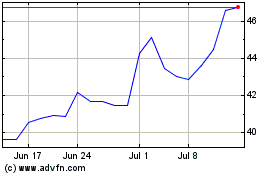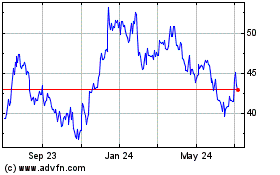The softening market for bank stocks threatens to cool the TARP
program's hot returns.
As U.S. banks have returned to health following the worst
financial crisis in decades, the U.S. Treasury has shared in their
gains. Banks that have exited the government's Troubled Asset
Relief Program, or TARP, have on average earned taxpayers 10.3% in
annualized returns for their investments, according to Keefe
Bruyette & Woods. Wall Street firms Goldman Sachs Group Inc.
(GS) and Morgan Stanley (MS), which each repaid their $10 billion
in government investments last summer, generated returns of nearly
20% and 16%.
Now, with financial stocks sliding, the Treasury and taxpayers
are facing the prospect of diminishing returns as more companies
repay their public support.
The government is "still going to make a nice return," said Fred
Cannon, co-director of research at Keefe Bruyette & Woods. "But
I'm not sure the 10% will hold up."
Here's why: While the government got a 5% dividend on preferred
stock it received under TARP, its ultimate return depends in part
on where that company's stock is trading when the government gets
paid for warrants that were also part of the TARP investments. And
lately, the market for bank stocks has belonged to skeptical
buyers.
Financial stocks in the Standard & Poor's 500 have fallen
about 18% since April, threatening the size of proceeds from the
government's sales of the stock warrants. (Volatility and term also
influence the pricing of options.)
Nearly two years ago, as the financial crisis threatened to
implode the U.S. economy, the Treasury used TARP to make hundreds
of billions of dollars in investments in private companies in order
to stabilize the U.S. financial system. As the healthiest of those
companies exit the program, U.S. taxpayers have been compensated
for crisis-hour rescue.
In July, as economic fears faded and bank stocks rallied, the
government started selling its warrants--in some cases, back to the
companies themselves. When companies didn't buy at the government's
price, Treasury sold the warrants at auction. By the end of May,
the Treasury had raked in $6.8 billion just from warrants tied to
the 14 biggest banks to exit TARP.
For the roughly 60 financial firms that have exited the
program--including much smaller institutions like First Manitowoc
Bancorp Inc. (FMWC) and Old Line Bancshares Inc. (OLBK)--the
Treasury has collected proceeds of $6.98 billion on the warrants
and $5.55 billion on the dividends on the preferred shares, KBW
said in an analysis released Tuesday. That's an annualized return
of 10.3% on the $131.8 billion that the government initially
invested in those companies, according to KBW.
The government has yet to sell warrants tied to insurer Hartford
Financial Services Group Inc. (HIG), credit card lender Discover
Financial Services (DFS) and lender Webster Financial Group (WBS),
among others.
Hundreds of companies in the TARP program, of course, have yet
to repay their investments, including Detroit-based automakers
General Motors Co. and Chrysler Holding Co.
Moreover, the rescued giant insurer American International Group
Inc. (AIG), along with nearly 100 smaller banks, have missed
dividend payments to the government due to their poor financial
condition. And the government has taken permanent losses from a
handful of TARP participants, including CIT Group Inc. (CIT), which
filed for bankruptcy.
The government's $3.4 billion stake in American Express Co.
(AXP) produced the best return, at 23.3%.
Government officials used the TARP funds, which were authorized
by Congress, to stabilize a wide range of firms, ranging from small
banks to car companies. Only a handful of the selected companies
have so far repaid the investments, but some of those that did have
paid handsomely for the help.
Goldman and Morgan Stanley each received investments of $10
billion, and the government collected returns on those investments
of 19.9% and 16.3%, respectively.
The nation's three big trust banks, Bank of New York Mellon
Corp. (BK), State Street Corp. (STT) and Northern Trust Corp.
(NTRS), also accounted for solid gains for taxpayers. From its $3
billion investment in BNY Mellon, the government returned 10.1%.
The $2 billion in State Street produced returns of 9% and the $1.6
billion that Northern Trust accepted returned 11%.
The Treasury's investments in more traditional banks, like J.P.
Morgan Chase & Co. (JPM) and Bank of America Corp. (BAC), have
turned in smaller returns.
The $25 billion investment in Bank of America returned 8.3%,
while identical investments in J.P. Morgan and Wells Fargo &
Co. (WFC) returned 6.2% and 5.8%, respectively.
The government's investment in strong U.S. regional banks have
also produced solid returns. A $6.6 billion investment in U.S.
Bancorp (USB) returned 7.7%, and the Treasury's $7.6 billion
investment in PNC Financial Services Group Inc. (PNC) returned
7.3%. Capital One Financial Corp.'s (COF) $3.6 billion returned
6.7%, while BB&T Corp.'s (BBT) $3.1 billion returned 7.5%.
Warren Buffett's investment in Goldman has so far soared past
those returns, with an annualized return of 36%, according to Dr.
Linus Wilson, a finance professor at University of Louisiana at
Lafayette who has authored a paper about Berkshire's Goldman
investment.
In September 2008, shortly before the government took its stake
in Goldman, Warren Buffett, the billionaire chairman of Berkshire
Hathaway Inc. (BRKA, BRKB), agreed to buy $5 billion in preferred
shares from Goldman. He negotiated a hefty 10% dividend and
demanded, as a bonus, warrants to buy $5 billion of Goldman stock
at $115 a share.
That means that the Oracle of Omaha's eventual return, just like
some of the government's, depends in part on the future price of a
single stock.
-By Marshall Eckblad, Dow Jones Newswires; 212-416-2156;
marshall.eckblad@dowjones.com
(Matthias Rieker contributed to this article.)
Webster Financial (NYSE:WBS)
Historical Stock Chart
From Mar 2024 to Apr 2024

Webster Financial (NYSE:WBS)
Historical Stock Chart
From Apr 2023 to Apr 2024
